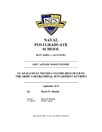Promoting Spatial Data Use Via Open Architectures and X3D [video]
| dc.contributor.author | Tourtelotte, Dale R. | |
| dc.contributor.author | Brutzman, Don | |
| dc.date.accessioned | 2015-08-12T15:53:54Z | |
| dc.date.available | 2015-08-12T15:53:54Z | |
| dc.date.issued | 2010-03-08 | |
| dc.identifier.uri | https://hdl.handle.net/10945/46009 | |
| dc.description.abstract | In large measure, the vision of making it easier to create and use 3D spatial data has been achieved through The Extensible 3D (X3D) Earth project. This project created a standards-based 3D visualization infrastructure for visualizing all manner of real-world objects and information constructs in a geospatial context. The ability to archive models using stable commercial tools and noncommercial international standards ensures that 3D work can remain accessible and repeatable for many years to come. In this presentation we shall describe how we leveraged the NPS Supercomputer 'hamming' to defray the huge investment involved in the project through server-side preparation of content, interlocking/addressable URL schemes, ability to add new X3D Earth content, ability to efficiently mirror resources, streaming of relevant X3D Earth data, etc. over high-performance networks such as CENIC. | en_US |
| dc.format.extent | 406 MB. Duration: 00:29:23 | en_US |
| dc.language.iso | en_US | |
| dc.publisher | Monterey, California: Naval Postgraduate School. | en_US |
| dc.rights | This publication is a work of the U.S. Government as defined in Title 17, United States Code, Section 101. Copyright protection is not available for this work in the United States. | en_US |
| dc.subject | Brutzman | en_US |
| dc.subject | CENIC | en_US |
| dc.subject | MOVES | en_US |
| dc.subject | X3D | en_US |
| dc.title | Promoting Spatial Data Use Via Open Architectures and X3D [video] | en_US |
| dc.type | Video | en_US |
Files in this item
This item appears in the following Collection(s)





